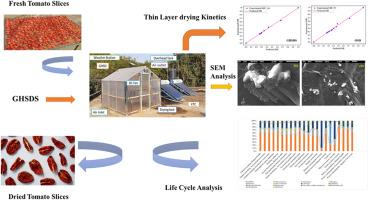温室日光系统中番茄干燥的多维研究:从生命周期对品质特性的影响
IF 6.3
2区 材料科学
Q2 ENERGY & FUELS
引用次数: 0
摘要
本研究的重点是对印度中央邦瓜廖尔开发的两种不同的太阳能干燥系统进行生命周期评估。研究了温室日光干燥系统(GHSDS)下番茄片的热特性和形态分析,并与传统的露天日光干燥(OSD)方法进行了比较。实验评估了两种干燥技术下番茄干片的干燥特性、传质系数和品质。GHSDS的最高温度为59.5°C,太阳强度为855 W/m2。在10 h内,GHSDS和OSD处理的番茄片初始水分含量分别从81.25%和11.22%下降到11.22%和22%。GHSDS处理的干燥速率分别为0.65和0.61 kg水/kg固体。hr表示OSD。Prakash和Kumar模型准确地描述了两种方法的干燥动力学。与OSD相比,GHSDS的有效水分扩散率提高了6.45%,传质系数提高了7.07%,换热系数提高了46.6%。GHSDS和OSD的活化能分别为35.32 kJ/mol和61.54 kJ/mol。采用生命周期评价(LCA)技术比较了GHSDS与抛物式太阳能干燥系统(PSDS)的环境影响。结果显示两种系统在所有评估类别之间存在显著差异。与PSDS相比,GHSDS始终显示出较低的环境影响。本研究首次整合了温室日光干燥番茄片的干燥动力学、热性能、质量评估、形态分析和全生命周期评估。本文章由计算机程序翻译,如有差异,请以英文原文为准。

A multidimensional study on tomato drying in greenhouse solar systems: From life cycle impacts on quality characteristics
This study focuses on the performing a life-cycle assessment of two different solar drying systems developed in Gwalior, Madhya Pradesh, India. Present study evaluates the thermal characteristic and morphology analysis of tomato slices in a greenhouse solar drying system (GHSDS) and compares it with traditional open sun drying (OSD) methods. Experiments assessed drying characteristics, mass transfer coefficient, and quality of dried tomato slices under both drying techniques. The GHSDS achieved a maximum temperature of 59.5 °C with solar intensity of 855 W/m2. The initial moisture content of 81.25 % in tomato slices decreased to 11.22 % in GHSDS and 22 % in OSD within 10 h. Drying rates were 0.65 for GHSDS and 0.61 kg water/kg solid. hr for OSD. The Prakash and Kumar model accurately described the drying kinetics for both methods. GHSDS showed increases of 6.45 % in effective moisture diffusivity, 7.07 % in mass transfer coefficient, and 46.6 % in heat transfer coefficient compared to OSD. Activation energy () was 35.32 kJ/mol for GHSDS and 61.54 kJ/mol for OSD. The Life Cycle Assessment (LCA) technique was employed to compare the environmental impacts of a GHSDS with those of a parabolic solar drying system (PSDS). The results revealed significant differences between the two systems across all evaluated categories. The GHSDS consistently demonstrated a lower environmental impact compared to the PSDS. This study is the first to integrate drying kinetics, thermal performance, quality assessment, morphology analysis, and a full Life Cycle Assessment of greenhouse solar drying for tomato slices.
求助全文
通过发布文献求助,成功后即可免费获取论文全文。
去求助
来源期刊

Solar Energy Materials and Solar Cells
工程技术-材料科学:综合
CiteScore
12.60
自引率
11.60%
发文量
513
审稿时长
47 days
期刊介绍:
Solar Energy Materials & Solar Cells is intended as a vehicle for the dissemination of research results on materials science and technology related to photovoltaic, photothermal and photoelectrochemical solar energy conversion. Materials science is taken in the broadest possible sense and encompasses physics, chemistry, optics, materials fabrication and analysis for all types of materials.
 求助内容:
求助内容: 应助结果提醒方式:
应助结果提醒方式:


